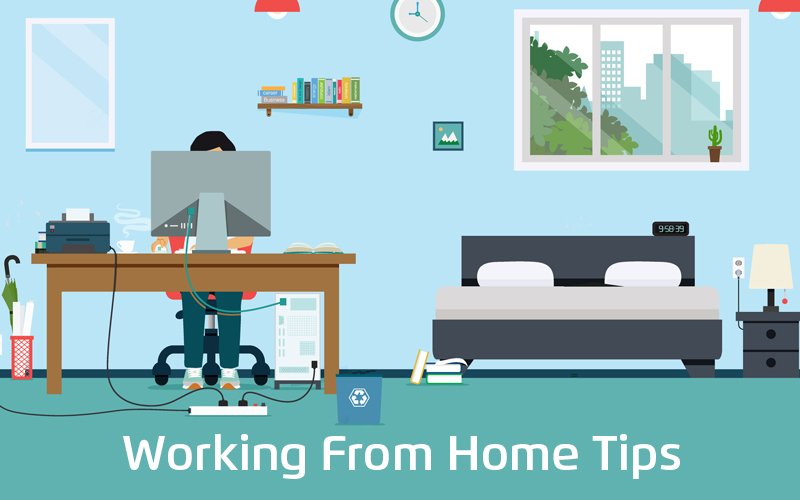The concept of Working from home tips has become increasingly prevalent in today’s digital age, offering individuals the flexibility to balance professional responsibilities with personal obligations.
With advancements in technology and changes in workplace dynamics, more people are embracing remote Working from home tips as a viable alternative to traditional office-based employment. However, transitioning to a remote work environment comes with its own set of challenges and considerations.
In this article, we will explore practical tips and strategies for effectively working from home, maximizing productivity, and maintaining a healthy work-life balance.
Whether you’re a seasoned remote worker or new to the concept, these tips will help you navigate the remote Working from home tips landscape with confidence and success.
Establishing a Dedicated Workspace

Establishing a dedicated workspace is essential for maintaining productivity and focus while Working from home tips. Here are some key considerations:
- Choose a Quiet and Comfortable Area: Select a space in your home that is free from distractions and conducive to concentration. Ideally, this area should be quiet, well-lit, and comfortable for extended periods of work.
- Set Up Ergonomic Furniture: Invest in ergonomic furniture, such as a supportive chair and a desk at the appropriate height, to promote good posture and prevent discomfort or strain during long hours of work.
- Organize and Declutter: Keep your workspace organized and clutter-free to minimize distractions and create a conducive environment for productivity. Use storage solutions like shelves, drawers, and organizers to keep essential items within reach but out of the way.
- Personalize Your Space: Make your workspace your own by adding personal touches like photos, artwork, or plants. Personalizing your environment can help you feel more comfortable and motivated while working.
- Minimize Distractions: Identify potential distractions in your workspace and take steps to minimize them. This may involve setting boundaries with family members or roommates, turning off notifications on your devices, or using noise-canceling headphones to block out background noise.
- Create Boundaries: Establish clear boundaries between your work area and the rest of your home to signal when you are in “work mode.” Communicate these boundaries to others in your household to minimize interruptions during designated work hours.
- Ensure Adequate Lighting: Ensure that your workspace is well-lit to reduce eye strain and fatigue. Natural light is ideal, but if that’s not possible, invest in task lighting to illuminate your work area effectively.
- Consider Privacy: If possible, choose a location for your workspace that offers privacy, especially if you need to participate in video calls or meetings. Consider using curtains, room dividers, or acoustic panels to create a private and professional environment.
By establishing a dedicated workspace tailored to your needs and preferences, you can create an environment that supports focus, productivity, and well-being while Working from home tips.
Communication Working from home tips
Effective communication is crucial when Working from home tips to ensure collaboration, clarity, and productivity. Here are some tips for improving communication while remote:
- Utilize Multiple Communication Channels: Use a combination of communication tools such as email, instant messaging, video conferencing, and project management platforms to stay connected with colleagues. Choose the appropriate channel based on the nature and urgency of the communication.
- Set Clear Expectations: Establish clear guidelines for communication, including response times, preferred channels for different types of communication, and availability during work hours. Ensure that everyone on the team is aware of these expectations to avoid misunderstandings.
- Schedule Regular Check-ins: Schedule regular check-in meetings with team members or supervisors to provide updates, discuss project progress, and address any concerns. These meetings can be conducted via video calls or conference calls to maintain connection and alignment.
- Be Proactive in Seeking Feedback: Actively seek feedback from colleagues or supervisors on your work to ensure that you are meeting expectations and addressing any areas for improvement. Don’t hesitate to ask for clarification or guidance when needed.
- Practice Active Listening: Practice active listening during virtual meetings or conversations by fully focusing on the speaker, asking clarifying questions, and summarizing key points to ensure understanding. Avoid multitasking or distractions during important discussions.
- Use Video Conferencing Effectively: When participating in video conferences or virtual meetings, ensure that you have a stable internet connection, use a professional background, and mute your microphone when not speaking to minimize background noise. Maintain eye contact and engage actively in the discussion.
- Be Responsive and Reliable: Respond promptly to messages and emails from colleagues to maintain momentum and keep projects moving forward. If you are unavailable or delayed in responding, communicate this to your team to manage expectations.
- Foster a Culture of Open Communication: Encourage open and transparent communication within your team by fostering a culture of trust, respect, and collaboration. Create opportunities for brainstorming, sharing ideas, and providing constructive feedback.
By implementing these communication tips, you can enhance collaboration, maintain alignment, and build strong relationships with colleagues while Working from home tips Effective communication is essential for success in a remote work environment.
Taking Regular Breaks and Practicing Self-Care

Taking regular breaks and practicing self-care are essential components of maintaining well-being and productivity while Working from home tips. Here are some tips to incorporate breaks and self-care into your remote Working from home tips routine:
- Schedule Breaks: Schedule regular short breaks throughout your workday to rest and recharge. Set reminders on your calendar or use time management apps to prompt you to take breaks at intervals that work for you.
- Take Active Breaks: Use your breaks to engage in physical activity or relaxation techniques to reduce stress and improve focus. Take a short walk, do some stretching exercises, or practice deep breathing exercises to refresh your mind and body.
- Disconnect from Screens: During breaks, step away from your computer and electronic devices to give your eyes and mind a rest. Limit screen time by engaging in activities that don’t involve screens, such as reading a book, listening to music, or spending time outdoors.
- Practice the Pomodoro Technique: Try using the Pomodoro Technique, which involves Working from home tips for a focused period (usually 25 minutes) followed by a short break (5 minutes). After four work intervals, take a longer break (15-30 minutes) to recharge before starting the cycle again
- Eat Nutritious Meals and Stay Hydrated: Fuel your body with nutritious meals and snacks throughout the day to maintain energy levels and concentration. Drink plenty of water to stay hydrated and avoid fatigue.
- Establish Boundaries: Set boundaries between work and personal time to prevent burnout and maintain work-life balance. Clearly define your work hours and avoid working outside of those designated times. Communicate your boundaries to colleagues and supervisors to respect your time off.
- Practice Mindfulness and Stress Reduction: Incorporate mindfulness practices into your daily routine to reduce stress and promote relaxation. Try meditation, yoga, or mindfulness exercises to stay grounded and centered during challenging times.
- Prioritize Sleep: Ensure that you get an adequate amount of sleep each night to support overall health and well-being. Establish a consistent sleep schedule and create a calming bedtime routine to promote restful sleep.
By prioritizing regular breaks and practicing self-care, you can enhance your productivity, focus, and overall well-being while working from home. Remember to listen to your body and take breaks when needed to maintain balance and prevent burnout.
Embracing Technology and Productivity Tools

Embracing technology and productivity tools is essential for maximizing efficiency and effectiveness while Working from home tips. With the rise of remote Working from home tips, there has been an influx of innovative tools and software designed to streamline workflows, facilitate communication, and enhance collaboration.
By leveraging these tools, remote workers can overcome common challenges associated with distance and isolation, enabling them to stay connected, organized, and productive.
One key area where technology plays a crucial role is in communication and collaboration. Video conferencing platforms like Zoom, Microsoft Teams, and Google Meet allow remote workers to conduct virtual meetings, share screens, and collaborate on projects in real-time, regardless of geographical location.
Instant messaging apps such as Slack, Microsoft Teams, and Discord facilitate quick and seamless communication, enabling teams to stay connected and engaged throughout the workday.
Additionally, project management tools like Asana, Trello, and Monday.com help remote teams organize tasks, set deadlines, and track progress on projects. These tools provide visibility into project timelines, assign responsibilities, and streamline workflow management, ensuring that everyone stays aligned and productive.
Moreover, cloud-based storage solutions such as Google Drive, Dropbox, and OneDrive enable remote workers to access and share files securely from anywhere with an internet connection.
This eliminates the need for physical storage and enables seamless collaboration on documents, spreadsheets, and presentations.
Furthermore, productivity apps like Todoist, Evernote, and Toggl help remote workers prioritize tasks, manage time effectively, and stay focused on their goals.
These apps offer features such as task lists, reminders, time tracking, and goal setting, empowering individuals to optimize their workflow and achieve greater productivity.
Overall, embracing technology and productivity tools is essential for remote workers to thrive in today’s digital workplace.
By leveraging these tools effectively, remote Working from home tips can overcome the challenges of distance and isolation, collaborate seamlessly with colleagues, and achieve their goals with confidence and efficiency.
Conclusion
In conclusion, implementing effective strategies for Working from home tips is essential for maintaining productivity, well-being, and work-life balance.
While remote work offers flexibility and convenience, it also presents unique challenges that require proactive solutions.
By establishing a dedicated workspace, setting boundaries, managing distractions, and practicing self-care, remote workers can create a conducive environment for success.
Effective communication and collaboration are also key factors in remote Working from home tips success.
Utilizing technology and productivity tools to stay connected with colleagues, communicate effectively, and manage tasks can enhance efficiency and teamwork.
Additionally, prioritizing regular breaks, practicing mindfulness, and taking care of physical and mental health are essential for sustaining productivity and preventing burnout.
Other Questions
-
Why is establishing a dedicated workspace important?
Establishing a dedicated workspace helps create a conducive environment for focus and productivity.
-
How can one effectively manage distractions while Working from home tips?
Strategies include setting boundaries, minimizing interruptions, and utilizing time management techniques.
-
What role does communication play in remote Working from home tips?
Communication is crucial for staying connected with colleagues, collaborating on projects, and maintaining alignment.
-
Why is it important to take regular breaks while Working from home tips?
Regular breaks help prevent burnout, improve focus, and promote overall well-being.




